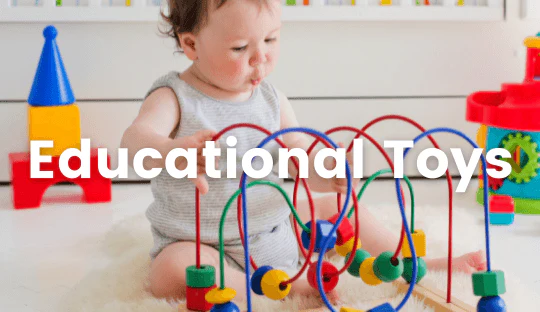In today’s rapidly evolving world, fostering creativity and innovative thinking in children is more crucial than ever. Toys and puzzles offer a fantastic avenue for children to develop these essential skills while having fun. Choosing the right playthings can ignite a passion for learning and problem-solving that extends far beyond the playroom.
Why Choose Toys and Puzzles for Innovative Learning?
Toys and puzzles provide a unique platform for children to learn through play. Unlike passive forms of entertainment, they actively engage a child’s mind, encouraging them to think critically, experiment, and find creative solutions to challenges. This process of playful exploration nurtures essential cognitive skills, including:
- Problem-Solving: Many toys and puzzles present challenges that require children to analyze, strategize, and test different approaches to find a solution. This process builds resilience and a growth mindset, teaching them that setbacks are opportunities for learning.
- Critical Thinking: Toys and puzzles often involve patterns, sequences, or rules that children must decipher. This encourages them to think logically, analyze information, and make connections.
- Spatial Reasoning: Building blocks, construction sets, and certain puzzles enhance a child’s understanding of spatial relationships, an essential skill for STEM fields.
- Fine Motor Skills: Manipulating small pieces and tools develops hand-eye coordination and fine motor control, crucial for writing, drawing, and other intricate tasks.
Top Toys and Puzzles to Spark Creativity
Selecting the right toys and puzzles can make all the difference in a child’s learning journey. Here are some top picks categorized by the skills they nurture:
1. Building and Construction Toys
- LEGO Bricks: A timeless classic, LEGO bricks offer endless possibilities for creative construction. Children can follow instructions to build specific models or let their imaginations run wild, designing and building their own creations.
- Magnetic Tiles: These colorful tiles connect magnetically, allowing children to create structures in three dimensions. This open-ended play fosters spatial reasoning and problem-solving skills as they experiment with different shapes and configurations.
- Wooden Blocks: Simple yet versatile, wooden blocks encourage imaginative play and structural exploration. Children can build towers, castles, or anything else they envision, developing their spatial awareness and problem-solving abilities.
2. STEM-Focused Toys
- Robotics Kits: These kits introduce children to the basics of robotics and coding through hands-on assembly and programming challenges. They can build and control their own robots, fostering problem-solving, critical thinking, and an early interest in STEM fields.
- Circuit Building Sets: These sets allow children to experiment with circuits and electricity in a safe and engaging way. They learn about concepts like conductivity and circuits while developing problem-solving and critical thinking skills.
- Coding Games and Apps: Interactive coding games and apps make learning to code fun and accessible. These tools often use game-like challenges and puzzles to teach coding concepts, logic, and problem-solving.
3. Puzzles for Cognitive Development
- Jigsaw Puzzles: From simple to complex, jigsaw puzzles enhance spatial reasoning, problem-solving, and fine motor skills. They teach children to identify patterns, analyze shapes, and think strategically to complete the image.
- Tangrams: These ancient Chinese puzzles consist of seven geometric shapes that can be arranged to create various figures and designs. Tangrams develop spatial reasoning, problem-solving, and geometric understanding.
- Logic Puzzles: Sudoku, KenKen, and other logic puzzles challenge children to use deductive reasoning, pattern recognition, and strategic thinking to find solutions. These puzzles are excellent for developing critical thinking and problem-solving skills.
4. Creative Arts and Crafts Supplies
- Art Supplies: Providing a variety of art supplies like crayons, markers, paint, clay, and paper encourages self-expression and creativity. Open-ended art activities allow children to explore their imaginations, experiment with different mediums, and develop their fine motor skills.
- DIY Kits: Do-it-yourself kits, such as jewelry making, soap making, or slime kits, provide structured creative activities that result in tangible creations. These kits foster a sense of accomplishment, encourage following instructions, and often incorporate elements of science and art.
5. Imaginative Play Toys
- Dolls and Action Figures: Dolls and action figures encourage imaginative storytelling and role-playing. Children create narratives, develop characters, and act out scenarios, fostering language development, social-emotional skills, and creativity.
- Play Kitchens and Tool Sets: These toys allow children to mimic real-life activities, fostering imaginative play, social interaction, and an understanding of the world around them.
- Costumes and Dress-Up Clothes: Dress-up clothes encourage imaginative play, role-playing, and self-expression. Children can step into different roles and create their own worlds, fostering creativity and social-emotional development.
Choosing the Right Toys and Puzzles
When selecting toys and puzzles to promote innovative learning, consider your child’s age, interests, and developmental stage. Look for toys that offer open-ended play, encouraging children to explore, experiment, and use their imaginations. Most importantly, choose toys and puzzles that are engaging and fun, sparking a love of learning that will last a lifetime.
Buy now at SupereDuck.com
